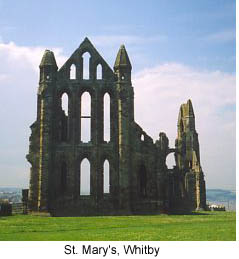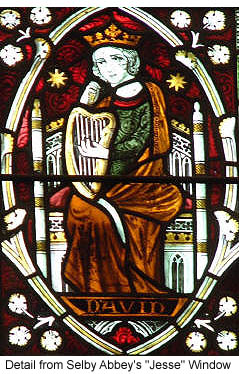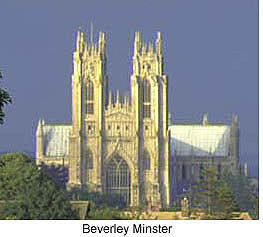The Hidden Churches of Yorkshire
by Louise Simmons
Churches, cathedrals, abbeys, minsters -- Yorkshire abounds with them, and of them all, York Minster must be one of the most famous. But there's a lot more to York -- and Yorkshire -- than the Minster.
For a real trip back in time, head for the village of Lastingham, about twenty miles in from the coast, just north of Scarborough. St Cedd built a monastery there in 654 as an outpost of Lindisfarne, which had been founded just 19 years previously. In the 9th century the monastery was abandoned during Viking raids, and it wasn't until the second half of the 11th century that a church was rebuilt, including the crypt, dedicated to St Cedd, which is still there today. It was abandoned again for a time, but has been an active parish church since the 13th century. The crypt, with its columns and capitals remarkably untouched by time, looks today just as it must have done almost a millennium ago.
 While you're in the area, take the A169 north to the seaside town of Whitby. Although the town itself is at sea level, built around the old fishing port, St Mary's church sits up on the cliff top, at the top of a long -- and steep -- flight of steps, and between the town and the ruined abbey (there has been an abbey on the site since the late 7th century, although it was rebuilt in the 1070s). The craftsmen who carved the pews and pillars probably spent much of their time building ships, and the similarity shows. The overall effect is cosy -- helped by the still-working stove which sits amongst the pews.
While you're in the area, take the A169 north to the seaside town of Whitby. Although the town itself is at sea level, built around the old fishing port, St Mary's church sits up on the cliff top, at the top of a long -- and steep -- flight of steps, and between the town and the ruined abbey (there has been an abbey on the site since the late 7th century, although it was rebuilt in the 1070s). The craftsmen who carved the pews and pillars probably spent much of their time building ships, and the similarity shows. The overall effect is cosy -- helped by the still-working stove which sits amongst the pews.
On a much grander scale is Selby Abbey. Originally a Benedictine monastery, the building that stands today (albeit restored after part of the tower collapsed in 1690, and then a major fire in 1906 melted the lead bells and caused considerable damage to the roof) was started in the 12th century. The abbey sits just three feet above the water table, though, and during building, as everything started to settle, subsidence and cracking became apparent. Eventually, when the tower settled, building recommenced, and the building was completed, although in all it took about 130 years to finish.
 The 13th century columns are richly adorned with carvings and the Norman nave is impressive indeed. Make sure you don't miss the stained glass east window, which depicts the Tree of Jesse: a pictorial representation of Christ's ancestral family tree, going back to the father of David, taken from the New Testament. Although more recently restored, much of the glass is from the original medieval window, and somehow survived the 1906 fire.
The 13th century columns are richly adorned with carvings and the Norman nave is impressive indeed. Make sure you don't miss the stained glass east window, which depicts the Tree of Jesse: a pictorial representation of Christ's ancestral family tree, going back to the father of David, taken from the New Testament. Although more recently restored, much of the glass is from the original medieval window, and somehow survived the 1906 fire.
Churches can gain much from their surroundings, and Yorkshire has its fair share of picturesque settings. One of the nicest is at Nun Monkton, a traditional, though unfortunately now less than typical English village complete with duck pond, village green and striped maypole. In an interesting deviation from normal tales of austerity, the original nuns at St Mary's -- a Benedictine convent -- were apparently renowned for their high living. Reputedly criticised for wearing jewellery and furs, enjoying splendid food and fine wine, and consorting with the local clergy, the nuns at the convent did not seem to have had to sacrifice as much for their religion as some of their less-worldly sisters. Much of the 13th century church was demolished during the Reformation; however the west wall and part of the nave have survived, and show some glorious detail in both the doorway and the internal arcading (considered to be amongst the best of its kind in northern England) along the upper levels. The east part of the church is Victorian, constructed when the rest of the building was restored.
Not all of Yorkshire's best churches date from the 12th and 13th centuries. One that's relatively modern, but still definitely worth a visit, is another St Mary, this one at Studley Royal. In the grounds of the Fountains Estate, which also includes a Cistercian Abbey, founded in 1132 and now an impressive ruin, an Elizabethan mansion and a Georgian water garden, St Mary's was designed and built by architect William Burges between 1870 and 1878. Being part of a World Heritage site, it's not exactly hidden, but this Victorian church is often overlooked in favour of Yorkshire's older buildings. Which is a shame, since particularly the interior of St Mary's is a wonderful example of Victorian style and Burges's work. A black and white nave, much use of coloured marble, floor mosaics and a stunning rose window in the east, letting in the morning light, all add to the highly decorative effect.
 It must be said that most of the more interesting churches are in North Yorkshire, thanks in part to the way the county boundaries have been redrawn over the years. But it would be a particular shame to be close to York and not cross into the East Riding of Yorkshire to visit Beverley, just north of Hull. Like York, Beverley has a minster: unlike York, this one remains a parish church, rather than a cathedral. Architecturally, though, it's on a par with its more famous cousin. Its interior boasts 13th century chancel and transepts, 14th century nave, 16th century choir stalls, and beautiful 18th century flooring. Lady Percy's tomb, dated at about 1340, is extravagantly decorated, and is a superb example of the sculpture of its time. The minster also houses dozens of carvings of musicians, a theme continued by Beverley's other magnificent church, St Mary's. Founded in the 12th century, much of St Mary's was rebuilt in the early 1500s after the tower collapsed into the nave. Beverley was a prosperous town at the time, and the church was restored in style. Look for the minstrels' capital up on one of the columns on the north side, which shows five painted musicians.
It must be said that most of the more interesting churches are in North Yorkshire, thanks in part to the way the county boundaries have been redrawn over the years. But it would be a particular shame to be close to York and not cross into the East Riding of Yorkshire to visit Beverley, just north of Hull. Like York, Beverley has a minster: unlike York, this one remains a parish church, rather than a cathedral. Architecturally, though, it's on a par with its more famous cousin. Its interior boasts 13th century chancel and transepts, 14th century nave, 16th century choir stalls, and beautiful 18th century flooring. Lady Percy's tomb, dated at about 1340, is extravagantly decorated, and is a superb example of the sculpture of its time. The minster also houses dozens of carvings of musicians, a theme continued by Beverley's other magnificent church, St Mary's. Founded in the 12th century, much of St Mary's was rebuilt in the early 1500s after the tower collapsed into the nave. Beverley was a prosperous town at the time, and the church was restored in style. Look for the minstrels' capital up on one of the columns on the north side, which shows five painted musicians.
Back in York itself, a visit to the Minster goes without saying. Yet it would be terrible to leave without visiting some of the city's other churches. One of the best features of York's many medieval parish churches is the stained glass, which has been preserved over the centuries. Perhaps the best example is at All Saints in North Street: the Pricke of Conscience window, constructed in the early 15th century, is based on a 14th century poem foretelling the 15 days to the end of the world, while the Corporal Acts of Mercy window shows a rich man visiting the sick and feeding the hungry. The Joys of the Virgin window is made of 14th century glass: there are many others, some restored from fragments of old glass, some resited during renovations, together making up a wonderful collection of medieval art.
Stained glass is also a feature at the other All Saints in York. Known as All Saints Pavement, it was mentioned in the Domesday Book and is now the guild church of York. It has an unusual octagonal lantern tower, once used to act as a beacon for travellers, and the crucifixion scene in the west window is made from early 14th century glass. On the way out, make sure you have a look at the door knocker: it's 12th century and is meant to represent the mouth of hell.
York's Holy Trinity Church
And finally, as a complete opposite to the grandeur and fame of York Minster, wander through the narrow alleyways of the old section of York until to you get to Goodramgate. Behind Lady Row (said to be the oldest row of houses in England) you'll find the churchyard of Holy Trinity Church. A 15th century church, with 17th and 18th century furnishings, it's calm, unspoiled and quite charming in its simplicity, although here too the lovely stained glass windows date back well over 500 years.
The large, grand cathedrals have their place, and are masters of architectural and decorative splendour, but the odd treasure, such as the minstrels' capital at Beverley, or the beautiful stained glass at All Saints, make seeking out some of the lesser-known churches a wonderfully enjoyable pastime.
Related Articles:
- Where Emperors, Kings and Saints Have Walked: York Minster, by Julia Hickey
- https://www.timetravel-britain.com/articles/churches/minster.shtml
- Four Great Abbeys and Priories of Yorkshire, by Dawn Copeman
- https://www.timetravel-britain.com/articles/churches/abbeys.shtml
- The Lingering Power of Fountains Abbey, by Julia Hickey
- https://www.timetravel-britain.com/articles/churches/fountains.shtml
More Information:
We regret that we no longer have the resources to maintain up-to-date links and/or hours and pricing details for the various sites and attractions listed on this website. For more information about the location(s) listed above, please use your favorite search engine or visit Wikipedia.
Louise Simmons is a Scottish freelance writer who lives in a 19th century farmhouse on the top of a hill in the middle of a sheep-farming area of central Scotland. An engineer by profession, after spending many years working in the IT industry in such unusual places as Nigeria, Russia and various oil rigs in the middle of the North Sea, she decided to take up her favourite occupation, writing, on a full-time basis, and currently writes for several online and print magazines. She particularly enjoys researching and writing about the history and culture of British people and places.
Article © 2005 Louise Simmons
Photos: Whitby Abbey courtesy of Whitby-uk.com; Jesse window courtesy of Selby Abbey; Beverly Minster courtesy of Britainonview.com; York Holy Trinity courtesy of Britainonview.com (Doug McKinlay).
|
